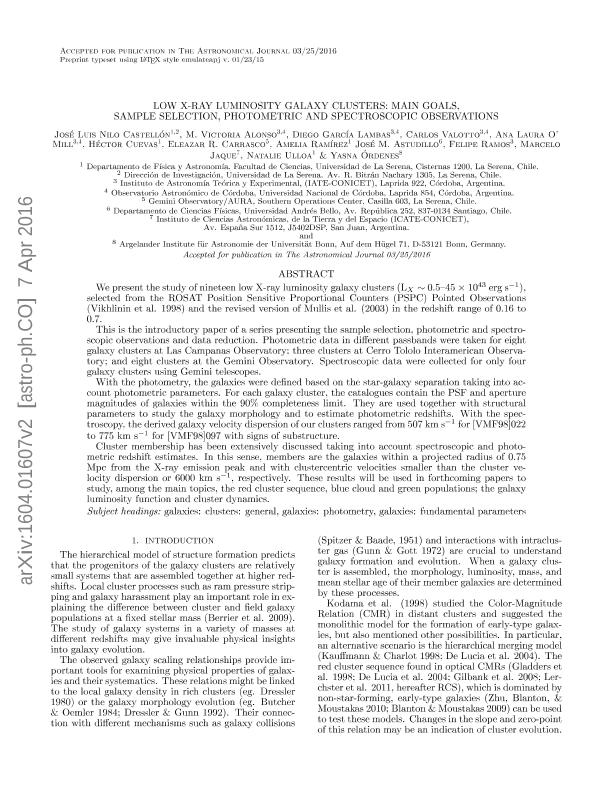Artículo
Low X-Ray Luminosity Galaxy Clusters: Main goals, sample selection, photometric and spectroscopic observations
Nilo Castellon, Jose Luis Emilio ; Alonso, Maria Victoria
; Alonso, Maria Victoria ; Garcia Lambas, Diego Rodolfo
; Garcia Lambas, Diego Rodolfo ; Valotto, Carlos Alberto
; Valotto, Carlos Alberto ; O'Mill, Ana Laura
; O'Mill, Ana Laura ; Cuevas, Héctor; Carrasco, Eleazar Rodrigo; Ramírez, Amelia; Astudillo, José M.; Ramos Almendares, Felipe Alberto
; Cuevas, Héctor; Carrasco, Eleazar Rodrigo; Ramírez, Amelia; Astudillo, José M.; Ramos Almendares, Felipe Alberto ; Jaque Arancibia, Marcelo Daniel
; Jaque Arancibia, Marcelo Daniel ; Ulloa, Natalie; Órdenes, Yasna
; Ulloa, Natalie; Órdenes, Yasna
 ; Alonso, Maria Victoria
; Alonso, Maria Victoria ; Garcia Lambas, Diego Rodolfo
; Garcia Lambas, Diego Rodolfo ; Valotto, Carlos Alberto
; Valotto, Carlos Alberto ; O'Mill, Ana Laura
; O'Mill, Ana Laura ; Cuevas, Héctor; Carrasco, Eleazar Rodrigo; Ramírez, Amelia; Astudillo, José M.; Ramos Almendares, Felipe Alberto
; Cuevas, Héctor; Carrasco, Eleazar Rodrigo; Ramírez, Amelia; Astudillo, José M.; Ramos Almendares, Felipe Alberto ; Jaque Arancibia, Marcelo Daniel
; Jaque Arancibia, Marcelo Daniel ; Ulloa, Natalie; Órdenes, Yasna
; Ulloa, Natalie; Órdenes, Yasna
Fecha de publicación:
06/2016
Editorial:
IOP Publishing
Revista:
Astronomical Journal
ISSN:
0004-6256
Idioma:
Inglés
Tipo de recurso:
Artículo publicado
Clasificación temática:
Resumen
We present our study of 19 low X-ray luminosity galaxy clusters (L 0.5-45 × 1043 erg s-1), selected from the ROSAT Position Sensitive Proportional Counters Pointed Observations and the revised version of Mullis et al. in the redshift range of 0.16-0.7. This is the introductory paper of a series presenting the sample selection, photometric and spectroscopic observations, and data reduction. Photometric data in different passbands were taken for eight galaxy clusters at Las Campanas Observatory; three clusters at Cerro Tololo Interamerican Observatory; and eight clusters at the Gemini Observatory. Spectroscopic data were collected for only four galaxy clusters using Gemini telescopes. Using the photometry, the galaxies were defined based on the star-galaxy separation taking into account photometric parameters. For each galaxy cluster, the catalogs contain the point-spread function and aperture magnitudes of galaxies within the 90% completeness limit. They are used together with structural parameters to study the galaxy morphology and to estimate photometric redshifts. With the spectroscopy, the derived galaxy velocity dispersion of our clusters ranged from 507 km s-1 for [VMF98]022 to 775 km s-1 for [VMF98]097 with signs of substructure. Cluster membership has been extensively discussed taking into account spectroscopic and photometric redshift estimates. In this sense, members are the galaxies within a projected radius of 0.75 Mpc from the X-ray emission peak and with clustercentric velocities smaller than the cluster velocity dispersion or 6000 km s-1, respectively. These results will be used in forthcoming papers to study, among the main topics, the red cluster sequence, blue cloud and green populations, the galaxy luminosity function, and cluster dynamics.
Archivos asociados
Licencia
Identificadores
Colecciones
Articulos(IATE)
Articulos de INST.DE ASTRONOMIA TEORICA Y EXPERIMENTAL
Articulos de INST.DE ASTRONOMIA TEORICA Y EXPERIMENTAL
Articulos(ICATE)
Articulos de INST.D/CS ASTRONOMICAS D/LA TIERRA Y DEL ESPACIO
Articulos de INST.D/CS ASTRONOMICAS D/LA TIERRA Y DEL ESPACIO
Citación
Nilo Castellon, Jose Luis Emilio; Alonso, Maria Victoria; Garcia Lambas, Diego Rodolfo; Valotto, Carlos Alberto; O'Mill, Ana Laura; et al.; Low X-Ray Luminosity Galaxy Clusters: Main goals, sample selection, photometric and spectroscopic observations; IOP Publishing; Astronomical Journal; 151; 6; 6-2016; 151-164
Compartir
Altmétricas



